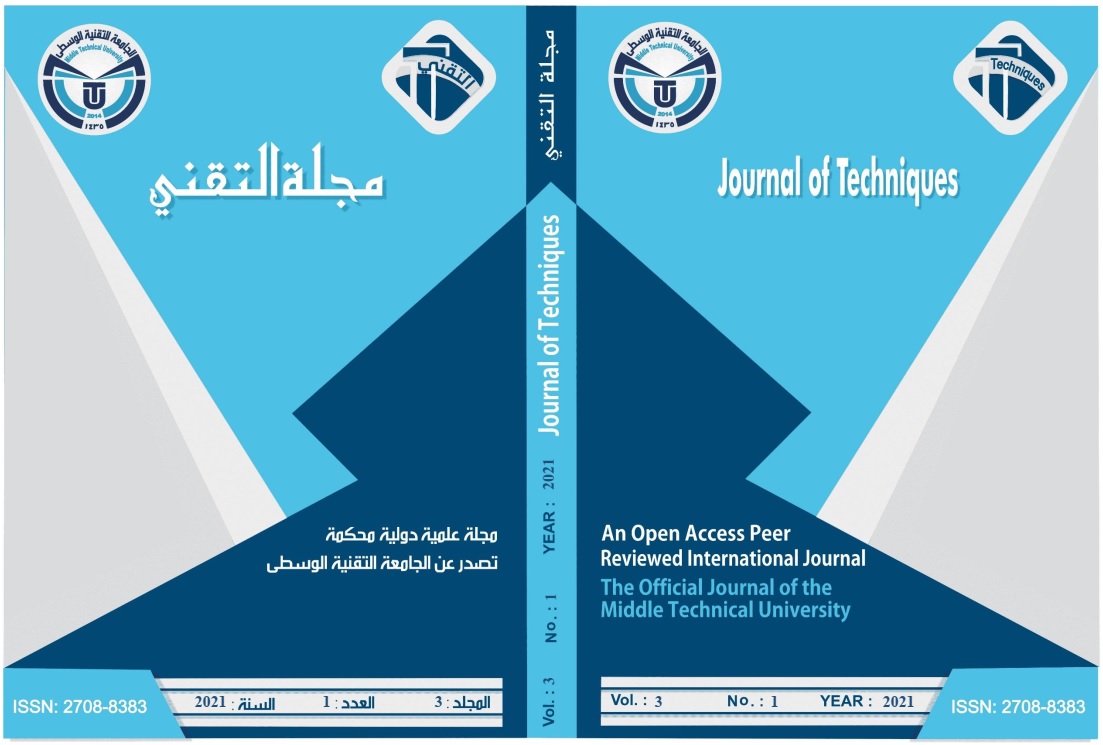Estimation of Apolipoprotein A1, Haptoglobin and Alpha 2macroglobulin with some Biochemical Metabolic Markers in Nonalcoholic Fatty Liver Disease Iraqi Patients
DOI:
https://doi.org/10.51173/jt.v3i1.263Keywords:
Apolipoprotein A1(APO A1), Haptoglobin (Hpt.), Alpha 2macroglobin(A2M), nonalcoholic fatty liver disease (NAFLD), metabolic diseaseAbstract
"non-alcoholic fatty liver disease" starts with hepatic lipid accumulation and is a dangerous factor for disease development.
Thus, we aimed to determine the serum levels of haptoglobin,alpha2 macroglobulin, apolipoprotein A1, gamma-glutamyl transferase, hemoglobin A1c, Total bilirubin, Triglyceride, cholesterol, low-density lipoprotein, high-density lipoprotein, very low-density lipoprotein, urea, and creatinine among patients with nonalcoholic fatty liver disease and healthy individuals. This study was carried out on 60 patients with NAFLD and 30 healthy subjects who were attending the Gastroenterology and Hepatology Teaching Hospital/Baghdad from August /2019 to March /2020. Patients data included age, sex, BMI, and abdominal ultrasound with other medical information. Serum samples were collected and then some biochemical tests were done by an Autoanalyzer, while serum apolipoprotein A1, haptoglobin, and Alpha 2maacroglobulin were measured by ELISA technique.
The study found that obesity (70%) and dyslipidemia (50%) are more common in NAFLD patients than another metabolic disease such as hypertension (20%) and diabetes mellitus (type 1 and 2) (3% and 30%) respectively. Also, the results showed a significant difference among the age group (p=0.006). NAFLD subjects had a highly significant elevation (p=0.000) in the mean ± SD of BMI, FBS, HbA1c, AST, ALP, cholesterol, triglyceride, LDL, VLDL, and Alpha 2 macroglobulin compared with the healthy control. Serum ALT and total bilirubin (mean ± SD) were significantly elevated (p=0.001) in NAFLD subjects (54.28±23.05IU/L and 14.47±9.65 µmole/l respectively) when compared with the mean± SD of healthy control. In addition, the results revealed a significant elevation (P=0.027) in the mean ± SD of serum albumin in NAFLD patients when compared with mean ± SD of healthy control and a significant elevation (P=0.002)in the mean ± SD of the LDL of the NAFLD patients as compared to the healthy control. However, the results showed a highly significant decrease (P=0.000) in the mean ± SD of serum HDL, Apolipoprotein, and haptoglobin. Furthermore, the present study observed that the optimal cut-off value was ≤67.13ng/ml for haptoglobin with a sensitivity and specificity of 80% and 93.33% respectively. In addition, the results revealed that the optimal cut-off value was >257ng/ml for Alpha 2Macroglobulin with a sensitivity and specificity of 73.33% and 86.67% respectively. The study found an optimal cut-off value of ≤86 ng/ml for Apolipoprotein A1 with a sensitivity and specificity of 85% and 90% respectively.
Downloads
References
J. A. López-Velázquez et al., “The prevalence of nonalcoholic fatty liver disease in the Americas,” Annals of Hepatology, vol. 13, no. 2. pp. 166–178, 2014, doi: 10.1016/s1665-2681(19)30879-8.
Z. M. Younossi, “Non-alcoholic fatty liver disease–A global public health perspective,” J. Hepatol., vol. 70, no. 3, pp. 531–544, 2019.
E. Hashimoto, M. Taniai, and K. Tokushige, “Characteristics and diagnosis of NAFLD/NASH,” J. Gastroenterol. Hepatol., vol. 28, pp. 64–70, 2013.
Z. Younossi et al., “Global burden of NAFLD and NASH: trends, predictions, risk factors and prevention,” Nat. Publ. Gr., vol. 15, no. 1, pp. 11–20, Jan. 2017, doi: 10.1038/nrgastro.2017.109.
M. Swain et al., “Biochemical Profile of Nonalcoholic Fatty Liver Disease Patients in Eastern India with Histopathological Correlation,” Indian J. Clin. Biochem., vol. 32, no. 3, pp. 306–314, 2017, doi: 10.1007/s12291-016-0612-7.
D. J. McLernon et al., “Prediction of liver disease in patients whose liver function tests have been checked in primary care: model development and validation using population-based observational cohorts,” BMJ Open, vol. 4, no. 6, 2014.
M. E. Rinella, “Nonalcoholic fatty liver disease a systematic review,” JAMA - J. Am. Med. Assoc., vol. 313, no. 22, pp. 2263–2273, 2015, doi: 10.1001/jama.2015.5370.
H.-K. Min et al., “Increased hepatic synthesis and dysregulation of cholesterol metabolism is associated with the severity of nonalcoholic fatty liver disease,” Cell Metab., vol. 15, no. 5, pp. 665–674, 2012.
N. C. Chavez-Tapia, N. Rosso, and C. Tiribelli, “Effect of intracellular lipid accumulation in a new model of non-alcoholic fatty liver disease,” BMC Gastroenterol., vol. 12, no. 1, p. 20, 2012.
S. L. Friedman, “Hepatic stellate cells: Protean, multifunctional, and enigmatic cells of the liver,” Physiological Reviews, vol. 88, no. 1. pp. 125–172, 2008, doi: 10.1152/physrev.00013.2007.
Y. He et al., “Apolipoprotein A1 forms 5/5 and 5/4 antiparallel dimers in human high-density lipoprotein,” Mol. Cell. Proteomics, vol. 18, no. 5, pp. 854–864, 2019.
J. Zhou et al., “Haptoglobin 2-2 Genotype is Associated with More Advanced Disease in Subjects with Non-Alcoholic Steatohepatitis: A Retrospective Study,” Adv. Ther., vol. 36, no. 4, pp. 880–895, 2019, doi: 10.1007/s12325-019-00902-z.
M. MacKellar and D. J. Vigerust, “Role of haptoglobin in health and disease: a focus on diabetes,” Clin. Diabetes, vol. 34, no. 3, pp. 148–157, 2016.
M. G. Sanal, “Biomarkers in nonalcoholic fatty liver disease-the emperor has no clothes?,” World J. Gastroenterol. WJG, vol. 21, no. 11, p. 3223, 2015.
Z. M. Younossi, A. B. Koenig, D. Abdelatif, Y. Fazel, L. Henry, and M. Wymer, “Global epidemiology of nonalcoholic fatty liver disease—meta‐analytic assessment of prevalence, incidence, and outcomes,” Hepatology, vol. 64, no. 1, pp. 73–84, 2016.
S. A. AlKhater, “Paediatric non‐alcoholic fatty liver disease: an overview,” Obes. Rev., vol. 16, no. 5, pp. 393–405, 2015.
M. Khoonsari et al., “Clinical manifestations and diagnosis of nonalcoholic fatty liver disease,” Iran. J. Pathol., vol. 12, no. 2, p. 99, 2017.
A. Tsuneto et al., “Fatty liver incidence and predictive variables,” Hypertens. Res., vol. 33, no. January 2010, pp. 638–643, 2015, doi: 10.1038/hr.2010.45.
K. J. Coppell, J. C. Miller, A. R. Gray, M. Schultz, J. I. Mann, and W. R. Parnell, “Obesity and the extent of liver damage among adult New Zealanders: findings from a national survey,” Obes. Sci. Pract., vol. 1, no. 2, pp. 67–77, 2015.
E. D’Adamo et al., “What is the significance of soluble and endogenous secretory receptor for advanced glycation end products in liver steatosis in obese prepubertal children?,” Antioxidants and Redox Signaling, vol. 14, no. 6. Mary Ann Liebert, Inc. 140 Huguenot Street, 3rd Floor New Rochelle, NY 10801 USA, pp. 1167–1172, 2011, doi: 10.1089/ars.2010.3719.
H. Yki-Järvinen, Yki-Järvinen - 2014 - Non-alcoholic fatty liver disease as a cause and a consequence of metabolic syndrome.pdf, vol. 2, no. 11. 2014, pp. 901–910.
H. Ma, C. Xu, L. Xu, C. Yu, M. Miao, and Y. Li, “Independent association of HbA1c and nonalcoholic fatty liver disease in an elderly Chinese population,” BMC Gastroenterol., vol. 13, no. 1, p. 1, 2013, doi: 10.1186/1471-230X-13-3.
S. Sunitha, R. Gandham, D. S. Wilma, and S. Rao, “Evaluation of significance of liver enzymes as screening tests for the early detection of clinically asymptomatic non alcoholic fatty liver disease in type 2 diabetes mellitus patients,” Int J Biomed Adv Res, vol. 6, no. 12, pp. 860–863, 2015.
S. Gowda, P. B. Desai, V. V Hull, A. A. K. Math, S. N. Vernekar, and S. S. Kulkarni, “A review on laboratory liver function tests,” Pan Afr. Med. J., vol. 3, 2009.
X. Su and D. Peng, “The exchangeable apolipoproteins in lipid metabolism and obesity,” Clin. Chim. Acta, vol. 503, no. 139, pp. 128–135, 2020, doi: 10.1016/j.cca.2020.01.015.
Y. Chang et al., “A cohort study of serum bilirubin levels and incident non-alcoholic fatty liver disease in middle aged Korean workers,” PLoS One, vol. 7, no. 5, p. e37241, 2012.
A. Salvatore, L. Cigliano, A. Carlucci, E. M. Bucci, and P. Abrescia, “Haptoglobin binds apolipoprotein E and influences cholesterol esterification in the cerebrospinal fluid,” J. Neurochem., vol. 110, no. 1, pp. 255–263, 2009.
Y. Yang, Z. Cao, L. Tian, W. T. Garvey, and G. Cheng, “VPO1 mediates ApoE oxidation and impairs the clearance of plasma lipids,” PLoS One, vol. 8, no. 2, p. e57571, 2013.
S. L. Friedman, “Hepatic stellate cells: Protean, multifunctional, and enigmatic cells of the liver,” Physiological Reviews, vol. 88, no. 1. pp. 125–172, 2008, doi: 10.1152/physrev.00013.2007.
N. M. Shalably et al., “Evaluation of Fucosylated Haptoglobin as a Diagnostic Biomarker for Hepatocellular Carcinoma in Egypt,” Open Biomark. J., vol. 9, no. 1, pp. 31–37, 2019, doi: 10.2174/1875318301909010031.
A. Shukla, S. Kapileswar, N. Gogtay, and A. Joshi, “fibrosis in patients with nonalcoholic fatty liver disease Simple biochemical parameters and a novel score correlate with absence of fibrosis in patients with nonalcoholic fatty liver disease,” no. September, 2015, doi: 10.1007/s12664-015-0580-5.
V. Ratziu et al., “Diagnostic value of biochemical markers (Fibro Test-FibroSURE) for the prediction of liver fibrosis in patients with non-alcoholic fatty liver disease,” BMC Gastroenterol., vol. 6, pp. 1–13, 2006, doi: 10.1186/1471-230X-6-6.
Downloads
Published
How to Cite
Issue
Section
License
Copyright (c) 2021 hiba abid Al-hussein hassan, Dawood Salman Dawood, Raghad Jawad Hussein

This work is licensed under a Creative Commons Attribution 4.0 International License.

















